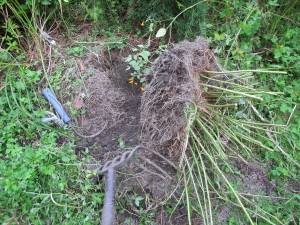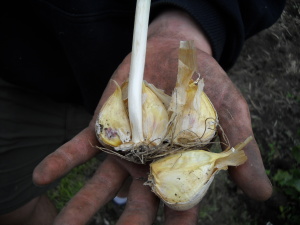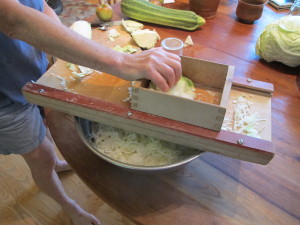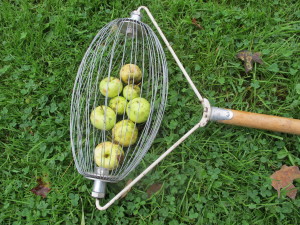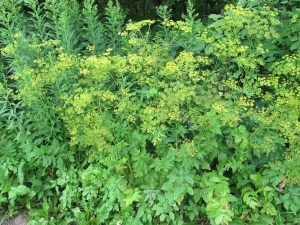Fall Chores
I love writing this weekly column. I do it 52 weeks of the year, and have been writing it since the fall of 1998 when I wrote my first column about putting the garden to bed. And the nature of gardening is such that I can write a column a little ahead of time so that I can, for example, go hike the Chemin de St Jacque de Compostelle in southwest France, which I am. Lucky me.
Here are some of the tasks I’d be doing at home this week, if I were there. First, I’d be weeding. Yes, weeds like to set their seeds in the ground in the fall for a new start in the spring. They seem to know that we are tired of pulling weeds now. But don’t let them get away from you. Pulling weeds now will save you lots of work next year – both in the vegetable garden and in the flower garden. A single weed might only produce a few hundred weeds – or up to a million for a mature purple loosestrife.
Before I left I did extra weeding. I love goldenrods, and actually planted some short ones last year, and some shade-loving ones. But the big boys, those goldenrods that get to be 6 feet tall, are too big to co-exist with most garden plants, so they had to come out. I had been leaving them in the ground as bees and other pollinators love the pollen. But before I left they had finished blooming and I dug some out before the seeds got distributed.
A big clump of goldenrod is not something that you can easily just pull out – unless you have a backhoe. First I take my pruners and cut back the stems so I am not fighting them or getting poked in the eye. Then I go around the perimeter of the clump with a shovel or drain spade and try to get under the clump. I push the shovel in on angle, then push down on the handle to see it I can get it to lift a little. When I have gone all the way around, I push down hard, and (hopefully) the clump tips over and I can drag it aside. For purple loosestrife, which has a massive root system, it is better to cut off the tops and burn them (or put in the household trash) than to let the seeds be distributed.
Before I left I also pulled out a lot of jewel weed (a.k.a. touch-me-not). Jewell weed has seed pods that explode when they are ripe, or if you touch them when they are almost ripe. Spring loaded. It is in the genus Impatiens, the same genus as our beloved shade annual. But this one will grow in the sun or shade. I let mine go to seed in recent years so my grandchildren could have the fun of touching them and seeing them explode. But now the population has exploded, so this year I worked hard to get them before seeds were set. They are an annual weed that is easy to pull.
Each fall I like to weed and prepare the beds in the vegetable garden for planting in the spring. I grow my veggies in wide, mounded beds. I like to loosen the soil in the walkways and then rake the soil into my beds. Then I add a layer of compost on top and stir it in. Finally, and I won’t do this until I return, I cover the beds with leaves and grass clippings collected by the lawnmower.
Every October I plant garlic for the next year, and you should, too. Buy seed garlic from your local farmer or get some at the local garden center. Grocery store garlic probably has been chemically treated to keep it from sprouting, so is not good. It is probably not the type we can grow here, which is called hard-neck garlic. Buy it as soon as you can, as many farms run out. I don’t need to buy garlic as I save my biggest and best bulbs of garlic to use as seed garlic.
If you’ve never planted garlic, here is what you do: Prepare a bed and enrich it with plenty of compost. I use my CobraHead weeder, which has a single tine, to make a furrow and then sprinkle in some organic bagged fertilizer, and stir that in. I take a bulb of garlic and separate the cloves – usually 5 to 7 per bulb. The roots are at the fat end, and the pointy end goes up. I plant the cloves about 3 to 4 inches apart and a couple of inches deep. Rows should be about 6 inches apart.
The final, most important thing to do –in terms of saving labor – is to heavily mulch the garlic bed. You can use mulch hay or straw, a layer of the fluffy stuff a foot thick will pack down to 4 inches by the end of winter. Garlic will pop right though that layer, but most weeds will not. And don’t worry if some garlic sprouts before snow flies, it will still re-sprout in the spring.
Last winter I managed to avoid killing my rosemary plant that I had brought in last fall and potted up. So this spring I planted it in the garden, where it has thrived. Now I need to pot it up again. Pot it up in potting soil mixed with compost.
Here’s the trick about bringing in rosemary: Do it now, and let it stay outside in the pot just where it has been all summer. That way you are changing only one variable at a time. If you dig it up and bring it in right away, it not only must get used to life in a pot, but life indoors. In a week or so, bring it inside. . Rosemary should survive temperatures down to 24 or 25 degrees.
And speaking of life indoors, on the next warm day wash all your houseplants with the hose to get off aphids and their eggs. Then let them dry in the sun and bring them in. You’ll have fewer aphids that way.
Henry is on vacation this week and will not be answering questions. His website is www.Gardening-Guy.com
Fermenting Foods
Many people believe that fermented foods – sauerkraut, yogurt, sourdough bread, for example – are better for you than other foods. For thousands of years people have fermented foods as way to preserve them, and scientists today note that fermenting foods can increase their content of vitamin C, thiamine and niacin, among other nutrients. Fermented vegetables help to promote a healthy gut and introduce beneficial bacteria into our bodies. And fermenting food is another way of preserving it for winter use.
We live in a society that minimizes contact with bacteria. Hand sanitizer is big business. Now probiotics (microorganisms introduced into the body for their beneficial qualities) are being sold and promoted in “live” yogurt and other probiotic preparations. But you can use your garden produce to make easy, tasty fermented foods that do much the same.
I recently met with a passionate food “fermentista”, Leslie Silver of Middletown Springs, Vermont and spent an afternoon making sauerkraut and other fermented foods. It’s easy. Leslie also told me about the 3rd Annual Vermont Fermentation Festival on October 3 at Green Mountain College in Poultney, Vermont. It is sponsored by RAFFL (www.rutlandfarmandfood.org) and organized by her. For $10 you can have a full day of learning!
Leslie explained that raw cabbage has naturally occurring bacteria that will ferment the sugars in the leaves without any introduction of bacteria on our part (most fresh fruits and vegetables has good bacteria, too). All we have to do is chop or finely slice the cabbage and add a teaspoon of salt for each pound of cabbage. The salt draws out the water and creates a brine. If you knead the salted cabbage like bread dough, soon there will be lots of liquid.
We packed chopped cabbage and other vegetables into wide-mouth quart jars and pressed out the air, allowing brine to cover the mix. Left open at room temperature the cabbage ferments and creates lactic acid and carbon dioxide that bubbles along, showing me that my sauerkraut is “working”. This kind of fermenting is called lacto-fermentation. (The lacto refers to lactic acid, not anything to do with milk).
Eventually the lactic acid brings the pH down to about 4.0, which stops the fermenting – and prevents other, harmful bacteria from affecting the food. Those same bacteria that cure the sauerkraut are beneficial to our gut.
If you want to learn how to make sauerkraut and other fermented veggies, I recommend working with an expert to really get first-hand knowledge of how to do it. We made 4 different recipes in 4 hours including 3 kinds of sauerkraut and a corn relish. All are delicious.
As an author (and a person of a certain age) I like to have a book in hand when learning a new skill. Leslie recommended Fermented Vegetables: Creative Recipes for Fermenting 64 Kinds of Vegetables in Krauts, Kimchis, Brined Pickles, Chutneys, Relishes & Pastes by Kirsten and Christopher Shockey, published by Storey Publishing. I got it, and like it. It has lots of good color photos and nice recipes. It explains the process well, without being overly technical.
The other book I got was a New York Times bestseller by Sandor Katz called The Art of Fermentation: An In-Depth Exploration of Essential Concepts and Processes from Around the World, published by Chelsea Green Publishing. This is also a great resource with information not only about fermenting vegetables, but also fruits, grains, milk, beans, meat and more. It has a glowing introduction from food writer Michael Pollan, who I trust. It’s excellent. The book is nearly 500 pages long, and seems to cover all aspects of fermenting, including lots of technical stuff.
Materials for fermenting veggies are minimal: You need a large bowl, containers and large sharp knife. Leslie also had a kraut board with 3 sharp blades. Run a cabbage across it and the shredded cabbage falls into the bowl.
We made small batches and put our krauts in wide-mouth glass jars. But, having fallen in love with specialty sauerkrauts, I have ordered from Gardeners Supply Company (www.gardeners.com or 888-833-1412) a 1.3 gallon Fermentation Crock kit, complete with lid and weights to keep the veggies in the brine (they tend to rise). I have old crocks, but this one has a water seal that allows the carbon dioxide to get out while keeping extraneous bacteria and yeasts out. For about $80, it seems like a good investment.
My krauts are tastier than any I’d ever had. In one I added fresh ginger, another has fennel seeds. It’s a good way to use kohlrabi, carrots, celeriac, too. I’ll be making more later this fall – once I get my new crock.
Henry is the author of 4 gardening books. He is not answering questions this week. His website is www.Gardening-Guy.com.
Tree-Related Fall Chores
It’s that time again. Time to think about getting ready for winter. Some trees are showing signs of changing leaf color. Vegetable gardens are winding down. Summer flowers are finished with their blooms, and even fall flowers are beginning to decline. Sigh. Summer is just about over.
Last winter we had record-setting snows in many places. One of the consequences of that was that meadow voles and other rodents had good protection from owls and hawks. Voles feasted on the bark of apple trees, stripping the bark with immunity – and fatally damaging many trees. A tree will slowly starve to death if it loses bark all around the trunk, although that may take a year or more. The leaves continue to produce the sugars all summer, but the damage prevents the sugars from getting to the roots – and they starve.
When my partner, Cindy Heath, retired after 26 years as director of Recreation and Parks in Lebanon, NH a nice crabapple tree was planted in her honor near the community garden. But last winter it was girdled by voles. So I hired a grafting specialist, Jenny Wright of Unity, NH, who met me last spring to do some repairs. She did what is called bridge grafting, grafting 4 twigs to span the damage. Two of the four grafts “took” and the tree has been saved. Even one successful graft probably would have worked. It’s probably not a job you can take on without help, but there are people who can help you.
Of course, the damage could have been prevented, and I would like to recommend that you take steps to protect any young fruit trees from similar damage if we have another snowy winter. Buy some “hardware cloth” and wrap it around the bottom 24 inches of the tree. Hardware cloth is a wire mesh that comes in a variety of sizes. Quarter inch mesh is best. You should be able to buy a small roll 24 inches wide. You will need tin snips to cut it and some wire to tie the ends together. For a 2-inch diameter tree, make a 4-inch diameter cylinder around it. Be sure to remove the wire mesh before the tree grows into it. Older trees are rarely eaten by rodents.
Another job for the fall is to clean up all those fallen apples that litter the ground. You may think they are harmless, but if you had any apple scab on your apples it is important to pick them up. If you don’t, come spring the fungal disease that causes scab will release spores and infect next year’s crop.
Raking up apples is tedious and often leads to damage to the lawn around a tree. But I have a “Nut Wizard”. It consists of a football-shaped wire device that turns on its axis when pushed across the ground by a long handle. The wires separate a little when going over an apple, which then enters the interior of the tool. When I have about 25 apples captured, I empty them into a wheelbarrow by separating the wires enough for the apples to fall out.
I got my Nut Wizard for about $50 from Elmore Roots Nursery (www.elmoreroots.com or (802) 888-3305). The greatest thing about it? My grandchildren love using it. Tom Sawyer would be proud of me!
If you have blackberries or raspberries, this is the time to cut down this year’s canes. Canes only produce for one year, and will only be in the way next year so cut them off near the ground. I use a pole pruner to cut the canes. I have a tool that works very well – it is lightweight and has a squeeze grip (like hand pruners). After snipping off a cane I can grab it with the blades (by squeezing very gently) and pull it out of the patch.
The tool I use is made by ARS, model LA 180 L1.8, which I got from OESCO tool company (www.oescoinc.com or 800-634-5557). It sells for about $100, but is well worth it if you have lots of berries and don’t like getting blood transfusions.
If you planted new trees or shrubs this year, it is important that they go into the winter well hydrated. Water them weekly as we go into the cold season if we don’t have a lot of rain.
Be sure newly planted trees are mulched with ground bark or wood chips. That will help keep the roots warm as winter approaches. Roots continue to grow even after leaf drop – until the ground gets too cold. A 3 to 4 layer of bark chips will allow them to grow longer into the autumn. But don’t let the mulch touch the tree – leave a donut hole around the trunk to avoid rotting of the tree bark.
Trees are my friends for lots of reasons, including the gift they bestow on me each fall. I don’t look on raking up leaves as a pain in the you-know-where. I look at leaves as a great source of organic matter and mulch for my gardens. I run them over with the lawn mower, and then rake them up. Once chopped and mixed in the some grass clippings, they don’t blow away. So keep that in mind when raking leaves instead of watching football!
Henry is the author of 4 gardening books. His website is www.Gardening-Guy.com.
Fall Lawn Care
This is a good time to do some improvements on your lawn. If you have crabgrass, lawn ivy (Creeping Charlie) or bare spots where the kids played badminton, now is the time to get to work. I recently called Paul Sachs, owner of North Country Organics and the author of three books on lawn care. He gave me some good suggestions.
Testing pH is a good first step, Sachs said. If your soil is too acidic or too alkaline, minerals can be bound up and unavailable to your turf plants even if they are present. You can get a simple test kit at a garden center, or take a sample and mail it to your state Extension Service soil testing lab for a more extensive report.
He warned that the first time someone adds limestone to their lawn – and fall is a good time for that – they may see a remarkable improvement the following spring. But, he warned, don’t keep on adding limestone without testing the pH. If you keep adding limestone every year your pH can get quite alkaline, which is just as bad as being too acidic.
According to Sachs, fall is a good time to overseed your lawn if you have thin or worn places, or if you have crabgrass. The soil is warm now, so new grass seeds will germinate more quickly than in the spring. Crabgrass, an annual, is declining in vigor so you can crowd it out by adding seed. Crabgrass seeds are not going to germinate until the spring, but if you can establish a nice thick turf now, crabgrass will have a hard time competing with it next spring.
It is best to sow a mixture of kinds of seed – a conservation mix that contains something like this: 35 percent creeping red fescue, 25 percent turf type tall fescue, 10 percent Kentucky bluegrass, 12 percent turf type perennial ryegrass, 15 percent annual ryegrass and 3 percent white clover. That mixture is good for a variety of soils and will thrive in full sun or even moderate shade.
Sachs told me that before you overseed an area, you should lower the height of the blades on your mower and give it a good haircut. That will allow newly started grass seeds to get more sunshine, which is important when it is getting established. So when filling in thin spots, you want to cut the grass close and allow new plants to develop.
Fall is also a good time to thicken the lawn by providing some fertilizer. An organic fertilizer like Pro-Gro will help roots to bulk up and winter-over better. Paul Sachs told me that when adding fertilizer it is good to keep the blades of mower up high, allowing each grass plant to have more surface area for photosynthesis. That will help to pump up its roots.
Knowing how much fertilizer to add and then figuring out how to spread it at the proper rate is a job for Einstein, I always thought. Paul Sachs helped me with the calculation. In general, he said you should add 20 to 30 pounds of fertilizer per 1,000 square feet of lawn if using Pro-Gro or other organic fertilizer with a 5-3-4 nutrient analysis (5-3-4 means 5 lbs of nitrogen, 4 of phosphate, 3 of potash per hundred weight).
A 20 by 50 foot section of lawn is 1,000 square feet. Figure out the total square footage of your lawn, calculate the amount of fertilizer you need for the job, and then buy the appropriate number of bags. Start applying it in a push-type spreader. If you set your spreader for a low rate of distribution, you can go over the lawn more than once until you have used all the fertilizer. Done. If part of the lawn got a little more than another part, no big deal – so long as every part of the lawn got some fertilizer.
Compaction makes it difficult to for grasses to thrive – except crabgrass, of course. That’s why crabgrass invades areas where you frequently walk. Years ago Sachs told me a simple way to test for compaction: you should be able to push a screwdriver with a 6-inch shaft into the lawn with moderate force. If you can’t, the lawn needs help.
You could hire a landscaper to come with a core-aerator or you could try to do something yourself. On-line I found an aerator at Sears for about $100 that can be pulled behind a riding lawn mower. It has 10 sharp steel stars that rotate and poke small 2-inch deep holes.
And then were the aerator sandals that strap onto your shoes with spikes that poke holes in the soil – only $16 but it would seem like a lot of work to aerate the lawn that way. Sachs said, “If you stomp your feet into really compacted soil, the only way to escape is to undo the straps and pry them out with your hands. I learned what it must feel like when a fly lands on fly paper.”
What about that pesky lawn ivy, commonly called Creeping Charlie? It is in the mint family and will grow almost anywhere. Sachs suggested raking it out with a short-tined garden and then fertilizing and overseeding. I tried raking it out, but found I pulled out my lawn grass, too. So maybe we just have to live with it. After all, if it’s green and you can mow it, I say it’s a lawn.
Henry is a gardening consultant and the author of 5 books. His website is www.Gardening-Guy.com. He lives and gardens in Cornish Flat, NH.



